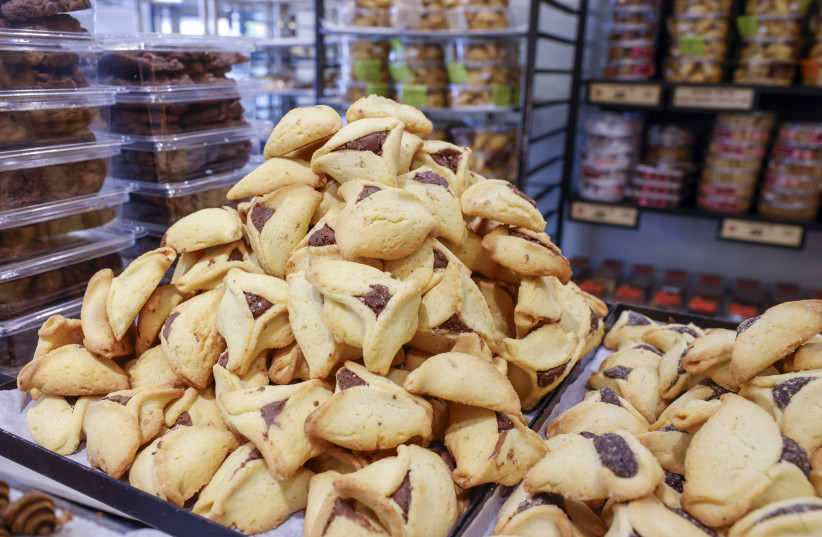
Purim is here, and that means it’s time for hamantaschen.
Known in Israel as oznei Haman (or, of late, as oznei Sinwar, in reference to infamous Hamas chief Yahya Sinwar), these triangular cookies may well be even more iconic than the Purim holiday itself.
Though the origin and etymology are up for debate, hamantaschen are known to have a long and storied history in Jewish culture.
What is universally agreed upon is the name of the cookies showing a tie to the story of Purim. Haman was the name of the antagonist of the Book of Esther, who sought to commit an act of unparalleled genocide against the Jews. What no one can wholly agree upon, though, is how exactly it relates to it. Many point to the Hebrew name of oznei Haman, meaning “Haman’s ears,” to claim it means that the wicked man had his ears chopped off before he was executed. Others point to the suffix of “tash,” meaning “weaken” in Hebrew, or meaning “pockets” in Yiddish.
But regardless, there is the matter of filling. With so many different types of filling available for these cookies, which is the best? Do people prefer the ever-enjoyable chocolate; classics like apricot jam; something out of the box like halva or peanut butter; or the classic but highly controversial (to put it politely) filling of pereg (a poppy seed paste also known as muhn). Obviously taste is subjective, so with that in mind, In Jerusalem did the legwork of going to a number of bakeries in the city, as well as polling Jerusalemites and the hardworking and opinionated staff of The Jerusalem Post to see what everyone preferred.

Overall, among the different vendors in the bustling Mahaneh Yehuda market, one trend was universal: When it comes to hamantaschen, chocolate is king. It was by far the most popular variant of hamantaschen at every bakery we could find.
And our data supports this. Chocolate was especially prevalent in several of the polls we put out. And nowhere was this more true than in The Jerusalem Post, as in our scientific sample of 23 staffers, it garnered over twice as many votes as any of the other options. In second place was a tie between apricot and pereg, with halva in a distant last place. Other standout choices among both the Post and other Jerusalemites included blueberry filling, strawberries, and the especially popular lemon curd. One commenter originally from Australia even suggested Vegemite.
But one other thing also became undeniable: People really like pereg, too. In fact, in our poll in the popular Secret Jerusalem Facebook group, it seemed that practically every other commenter was voicing support for pereg.
Pereg: The historic, beloved, and controversial poppy seed hamantaschen filling
Pereg is a controversial filling. Poppy seeds aren’t for everyone, and many people seem to prefer anything else to it. But it does have its staunch defenders, as well as those strongly opposed to it.
But why do people like it?
Some gave very sentimental explanations.
“My late dad, Hilly Linde, loved poppy seeds, so it was always my mission to get him pereg hamantaschen,” explained Steve Linde, editor-in-chief of The Jerusalem Report. “Over time, I acquired a taste for them, too.”
“I grew up with soft yeasty hamantaschen filled with poppy seeds,” said Jerusalem resident Elisheva Jeffay. “To my mind, nothing can beat those. But here in Israel, hamantaschen are the harder, cookie-based ones and just aren’t as good with poppy seeds inside.”
But to get a firmer answer, we asked the bakeries. Some bakers were puzzled, others just shrugged their shoulders and said, “Some people will buy anything.”
At one bakery, Magdanit Pe’er, the baker gave an unexpected answer when asked who buys pereg hamantaschen: “People 49 and up.”
But it was the beloved Duvshanit bakery that gave a different explanation.
“Pereg is the original,” the baker there said. “Nowadays, we have all sorts of flavors and fillings, from chocolate to apricot to halva. But the source of it all is pereg.” As for why people like it, the baker shrugged and said, “It’s a question of taste.”
But is pereg really the original hamantaschen flavor? Possibly. There is actually a lot of evidence to support this. Almost all of the earliest references to hamantaschen in either historic or halachic texts mention poppy seeds.
Even the Shulchan Aruch, the Code of Jewish Law itself, says that one should eat food made of poppy seeds.
The explanation goes to the Talmud, which, in Megillah 13a, states that Queen Esther subsisted almost entirely on seeds in order to keep kosher.
Does this mean that pereg hamantaschens are the halachicly correct ones? No, because there is no Halacha to eat hamantaschen at all. But it does mean that pereg was likely the original.
With that in mind, In Jerusalem editor Erica Schachne asked if I had bought any pereg ones for myself to try out.
My response? “Of course not. I hate poppy seeds!”
Purim sameach, everyone.■
